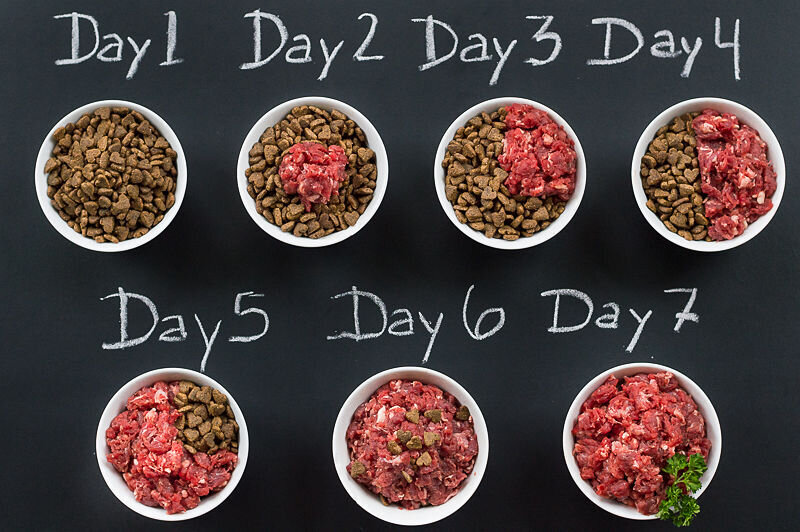Expect improved coat quality and energy levels when switching your dog to a raw diet. Digestive changes may also occur as their system adjusts. Transitioning your dog to a raw diet can be an impactful change in their feeding regimen.
This natural form of nutrition often leads to a shinier coat, higher energy levels, and improved overall health. The switch should be gradual to avoid gastrointestinal upset.
Dogs might experience changes in stool consistency and frequency as their digestive system adapts to the new diet. Raw diets for dogs are gaining popularity for their potential health benefits.
Pet owners should be prepared for a period of adjustment. Embracing this change involves observing your pet closely and consulting with a veterinarian to ensure a balanced diet and a smooth transition.

Benefits Of Raw Dog Food
Raw dog food may just be the switch that opens the door to a host of improvements, from enhanced digestion to a glossy coat. Let’s dig into the specific benefits that can arise when your dog embraces nature’s pantry.
Improved Digestion
Raw foods are packed with natural enzymes that aid digestion. Dogs process raw meat and vegetables differently from processed kibble. Owners often notice smaller and firmer stools, illustrating easier gastrointestinal processing.
Healthier Skin And Coat
The natural oils found in raw meat contribute to a radiant, healthy skin and coat. Omega fatty acids, inherent in raw diets, are the secret ingredient for that eye-catching shine.
Many guardians share stories of skin allergies diminishing after the switch, making raw food a potential ally for an itch-free, vibrant canine exterior.
Increased Energy Levels
A raw diet can transform a lethargic pup into one bursting with vitality. The nutrient-rich, unprocessed food fuels their bodies more efficiently, granting them the vigor for long walks and playful afternoons.
Pet parents often report a noticeable uptick in their dog’s zest for life post-diet change. Ready to witness a sprightlier, healthier companion? A raw food regimen could be a worthwhile venture for your beloved dog.
Transitioning To Raw Dog Food
When changing your dog’s diet to raw food, expect a journey that requires patience and attention. This switch can lead to a healthier lifestyle for your furry friend. Let’s look at how to make this transition smooth and stress-free for both you and your dog.
Gradual Introduction
Introducing raw dog food gradually is crucial to avoid digestive upset. Begin by mixing a small amount of raw food with their current diet.
Incrementally increase the raw food portion over several weeks. Observe your pet’s reaction at every step to ensure they adjust well.
- Day 1-3: 25% raw food with 75% current diet
- Day 4-6: 50% raw food with 50% current diet
- Day 7-9: 75% raw food with 25% current diet
- Day 10: Fully transition to raw food
Monitoring Health Changes
While transitioning, monitoring your dog’s health is essential. Not all dogs react the same way to dietary changes. Pay close attention to their energy levels, stool consistency, and overall well-being.
| What to Monitor | Healthy Signs | Warning Signs |
|---|---|---|
| Energy Levels | More active, playful | Lethargic, uninterested |
| Stool | Firm, less odorous | Loose, frequent, strong odor |
| Weight | Stable or improved muscle tone | Rapid loss or gain |
Regular check-ups with the vet ensure the transition is positive and healthy for your dog. Enjoy watching your dog thrive on their new diet!
Raw Diet Considerations
Choosing a raw diet for your dog involves important choices. Raw feeding takes careful planning. Your dog’s health comes first. Let’s explore key considerations.
Balanced Nutrition
Balance is crucial when shifting your dog to a raw diet. Dogs need proteins, fats, and carbohydrates. They also need vitamins and minerals. Here’s a simple guide:
- Proteins: Build and repair tissues. Include a variety of meats.
- Fats: Source of energy. Choose quality fats like fish oil.
- Carbohydrates: Provide energy. Some owners add fruits and vegetables.
- Vitamins & Minerals: Essential for body functions. Organs and bones can be good sources.
Consult with a veterinarian. They can recommend a balanced diet plan.
Safe Handling Of Raw Meat
Raw meat requires caution. Practice safe handling to avoid bacteria like Salmonella. Here are tips to keep in mind:
- Wash your hands before and after handling raw meat.
- Use separate utensils for dog food and human food.
- Store raw meat correctly. Refrigerate or freeze immediately.
- Clean all surfaces after preparing raw meals.
Keeping your kitchen safe is just as important as your dog’s diet.
Common Myths About Raw Dog Food
Many people worry before switching their dog to raw food. Let’s bust some myths!
Risk Of Bacterial Contamination
Is raw food safe? This is a big concern for pet owners. Many think that raw food is full of harmful bacteria. It’s true, raw food can have bacteria like any meat.
But, your dog’s stomach acid is strong. It kills most bad germs. Still, handle raw food with care. Wash your hands and clean all surfaces well. Your dog can enjoy their meaty meals safely!
Nutritional Imbalance
Another myth is that raw diets don’t have all the nutrients. Dogs need a balanced diet, and many believe raw food can’t provide this. The truth? A well-planned raw meal has all the right stuff.
Meat, bones, and organs give protein and minerals. Add in some veggies for vitamins. Balance is key. Consult a vet or a pet nutritionist to make sure your dog gets everything they need.
Conclusion
Switching your dog to a raw diet can bring noticeable changes. Expect improved coat health, increased energy, and potential weight stabilization. As you make this transition, monitor your pet’s reaction closely
Remember, every dog is unique. Consult your vet to tailor the diet to your dog’s needs. Embrace the journey to a thriving, happier pet.